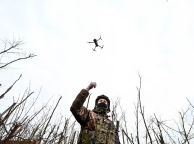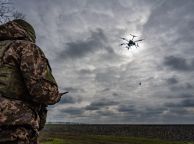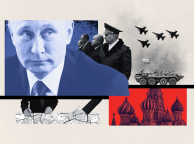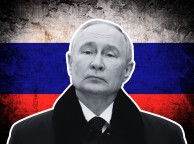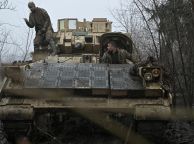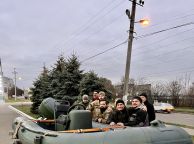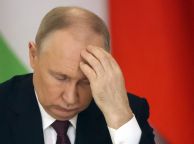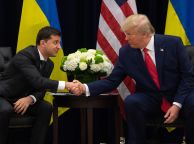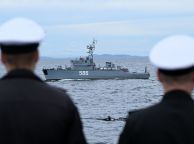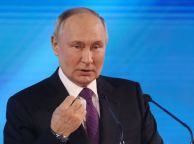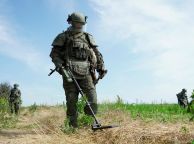By Jon Jackson
Ukraine has relied heavily on drones throughout its war against invading Russian forces, but many of those unmanned aircraft are no longer coming from the United States because of American drones' high cost.
The details of U.S. drones' shortcomings in the Ukraine war were detailed Wednesday in a published report. Along with being too expensive for Kyiv, American drones have not performed well against Russian defenses, according to the story in The Wall Street Journal.
Drones have become a valuable weapon for both sides during the war launched by Russian President Vladimir Putin in February 2022. Military analysts have credited Ukrainian drone strikes for putting Russia on the defensive in the Crimea region, and drones from Kyiv have made it all the way to Moscow.
But after an initial supply of American drones was sent to Ukraine during the early days of the war, Kyiv has increasingly turned to drones from China. The Journal wrote that Kyiv has "found ways to get tens of thousands of drones," along with drone parts, from the communist nation, which has a close alliance with Russia.
Georgii Dubynskyi, the deputy minister of the agency in charge of Ukraine's drone program, told the newspaper that while his country wants to try out more American drones, they are "looking for cost-effective solutions."
Along with high price tags, American drones have been too easy for Russia's defenses to detect. Many U.S.-made unmanned aerial vehicles (UAVs) have been found to be "glitchy and hard to repair," the Journal said, which doesn't justify the price when cheaper Chinese alternatives have gotten the job done on the battlefield.
"The general reputation for every class of U.S. drone in Ukraine is that they don't work as well as other systems," Adam Bry, an executive for Skydio, a Silicon Valley company that outfitted Ukraine with drones, told the Journal.
In a statement to Newsweek, a U.S. Department of Defense spokesperson said the department is "fully aware of the challenges faced by our Ukrainian partners in employing drones in the current conflict environment, particularly in the face of sophisticated Russian electronic warfare capabilities."
"We are working closely with our industry partners and Ukrainian counterparts to address these issues and ensure that the drones provided are as effective, reliable, and resilient as possible," the spokesperson wrote.
The statement added: "The DOD actively collaborates with the defense industry to identify, develop, and field technologies that can meet the rigorous demands of modern combat and electronic warfare environments. We are committed to supporting Ukraine's sovereignty and territorial integrity by providing them with the best possible mix of capabilities to counter Russian aggression.
"While we cannot comment on specific operational details, we continuously evaluate and improve the systems we provide to our allies, incorporating valuable feedback from operational environments to drive iterative improvements and innovations in our military capabilities."
Guy McCardle, managing editor of Special Operations Forces Report (SOFREP), told Newsweek that U.S. drones "no doubt" cost more than Chinese counterparts, "but it is an apples-and-oranges comparison."
"Most American drones are amazingly sophisticated and capable, even though they may be working out a few kinks encountered on the battlefield. This is to be expected as combat technology must constantly be refined and honed to remain cutting-edge," McCardle said. "Cheap Chinese drones are exactly that—stamped out by the millions and sold to both sides in the Ukraine-Russia war."
Meanwhile, Ukraine has made great strides in breaking its dependence on drones from its allies by dramatically ramping up production of domestic UAVs and first-person-view drones, as well as unmanned surface vessels, commonly known as sea drones.
McCardle described Ukrainian drones "as a sort of middle ground" between Chinese and American drones.
"Ukrainian drones, such as the SkyKnight, SHARK and Raybird-3, often utilize components common in the hobbyist drone market, indicating a focus on ease of assembly and operation," he said. These drones are designed for specific tasks like reconnaissance, targeting, and carrying small bombs...The cost difference is significant."
He added: "Ukrainian drones are somewhat effective for their intended limited roles and focus on direct support to military operations and a hands on operational approach."
During a year-end press conference this past December, Ukrainian President Volodymyr Zelensky announced a goal of domestic drone production reaching 1 million units in 2024.
Last month, Ukrainian Strategic Industries Deputy Minister Hanna Hvozdiar indicated the nation is ahead of schedule. Speaking on local television, she said Kyiv now has the capacity to produce 150,000 drones every month.
"Ukraine is already well past the million mark in terms of production," Hvozdiar said.



